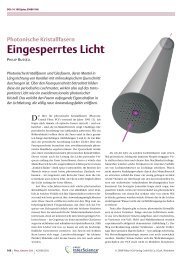Diploma thesis
Diploma thesis
Diploma thesis
Create successful ePaper yourself
Turn your PDF publications into a flip-book with our unique Google optimized e-Paper software.
the rotating wave approximation [18]:<br />
(ω−ωp)<br />
−<br />
αp(ω) = Ape 2σ (3.14)<br />
By substituting Equations 3.9, 3.10, 3.13 and 3.14 into 3.8, we obtain for the Hamiltonian:<br />
ˆH (�r, t) = χ (2)<br />
�<br />
dV<br />
� ∞ � ∞ � ∞<br />
(ω−ωp)<br />
−<br />
dω dωs dωiApe 2σ As(ωs)Ai(ωi)<br />
V<br />
0<br />
0<br />
0<br />
e i(� kp(ωp)− � ks(ωs)− � ki(ωi))�r e −i(ωp−ωs−ωi)t â † s (ωs) â †<br />
i (ωi) + h.c. (3.15)<br />
.The parameters for the envelope of signal and idler frequencies have been merged<br />
into As,i.<br />
We now assume that our initial state |ψ(t = 0)〉 is the vacuum state |0〉. The<br />
corresponding two-photon-state |ψs,i〉 evaluates to:<br />
|ψs,i〉 = |0〉 +<br />
� 1<br />
i� χ(2)<br />
psi<br />
� ∞ � ∞ � ∞<br />
0<br />
0<br />
0<br />
�� t<br />
(ω−ωp)<br />
− 2σp dω dωs dωiApe As(ωs)Ai(ωi) dt<br />
0<br />
′ e −i∆ωt′<br />
��<br />
·<br />
V<br />
dV e i∆� �<br />
k(ωp,ωs,ωi)�r<br />
â † s (ωs) â †<br />
i (ωi)<br />
�<br />
+ h.c.<br />
(3.16)<br />
The functions As,i and Ap are slowly varying with frequency, we hence treat them<br />
as constant and combine them with the susceptibility into the constant A ′ . Furthermore,<br />
the leading vacuum term is of no particular interest to us and will therefore<br />
be omitted in future calculations. The hermitian conjugate part covers the reverse<br />
process. Since only few photons are downconverted the reversal process is neglected.<br />
This leads to the following state:<br />
|ψs,i〉 = A ′ V<br />
� ∞ � ∞ � ∞<br />
0 0<br />
� �<br />
1<br />
·<br />
V<br />
0<br />
�� t<br />
dω dωs dωiα(ω)<br />
dt<br />
0<br />
′ e −i∆ωt′<br />
V<br />
dV e i∆� �<br />
k(ωp,ωs,ωi)�r<br />
â † s (ωs) â †<br />
i (ωi) |0〉 . (3.17)<br />
In this formula ∆k represents the momentum mismatch already introduced in the<br />
SHG treatment (Equation 3.3).<br />
∆k = kp(ωp) − ks(ωs) − ki(ωi) (3.18)<br />
We extent the integration time to ±∞, since we are interested in the steady state.<br />
With this simplification, the time integration is easily solveable and yields:<br />
� ∞<br />
dt ′ e −i∆ωt′<br />
= 2πδ(∆ω) (3.19)<br />
−∞<br />
The result is the well known energy conservation condition, with ∆ω = ωp − ωs − ωi,<br />
that replaces the frequency mismatch. We employ the energy conservation condition<br />
to get rid of the ω integration.<br />
�<br />
9<br />
�<br />
|0〉



